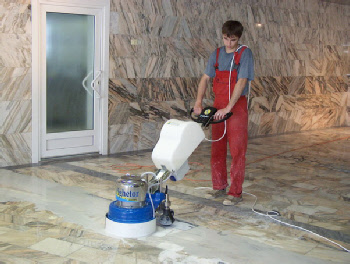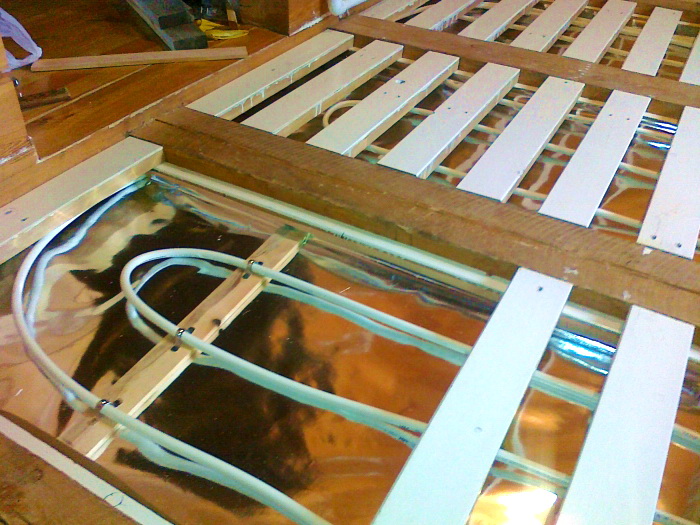GVL flooring: learning to work with gypsum fiber using the example of dry screed
In the understanding of the average layman, the floor is a covering with which his bare feet, dressed in slippers or shoes, touch. In fact, this is a complex structure, including at least a solid rough foundation, which creates a base for laying the coating, the leveling layer and the coating itself. The formation of just the leveling layer is the most time-consuming task, which can quickly be solved by sheets of guards that facilitate and accelerate this process.
Content
Gypsum fiber sheets - clean work, dry screed
Well-known among builders, sheets with the abbreviation GVL are modernized descendants of materials that were once called “dry plaster”. In the production of durable hard sheets, fibers of fluff pulp, used as a reinforcing component, and gypsum are used. The material obtained as a result of semi-dry pressing is distinguished by excellent technical qualities: excellent load-bearing ability, the absence of bending deformations, resistance to burning, low thermal conductivity.

The list of advantages is complemented by important technological advantages:
- simple operational laying of gvl on the floor;
- lack of waste, which is especially attractive for thrifty owners;
- the ability to almost immediately lay the finish coating without waiting for a long hardening period, as it should be when installing a floor with a cement screed.
The dominant technological advantage of GVL is the ability to level the surface in an extremely short time without wet, dusty, dirty work.
Leveling gypsum sheets are suitable for flooring:
- over concrete slabs and slabs of timber;
- on top of the leveling structure, for the construction of which logs were used;
- on top of a polymer and sand-cement screed.
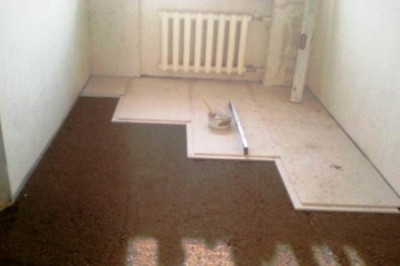
The leveling element of the gvl floor, in addition to all its priorities, improves the insulating properties of the structure due to the excellent insulating qualities. In addition, the material takes part in the formation of an optimal moisture level for breathing. It absorbs vaporous water in excess in the surrounding atmosphere and releases it back when there is a lack of wet suspension in the air.
Expanded clay is an environmentally friendly porous material, which is obtained by the method of expansion of low-melting clay rock. It is used for insulation and noise insulation of rooms. We will describe in detail about the material, its characteristics and methods of application, in the following article:https://floor.expertexpro.com/en/ustroistvo-rmnt/uteplenie-pola-keramzitom.html.
Types of Plaster Fiber Sheets
For the construction of a prefabricated base, two types of material can be purchased; different types of gvl for the floor are distinguished by the dimensions of the perimeter and the power of the plates:
- Standard GVL remind ordinary gypsum boards. Their sizes are regulated by GOST R51829-2001, they are 1200 × 1500 mm. This technological material is used not only for flooring, it is also used for leveling walls, forming partitions and creating a number of architectural elements.
- Small format GVL. They are two sheets connected by gluing together with mismatched, intersecting central axes, offset in two vector directions. Due to the displacement of one gypsum fiber sheet relative to another, a simple locking system is formed - a fold, which facilitates the installation and connection of the elements of the leveling layer. Their release is made according to the requirements of TU, small-format sheets are produced in two versions: 1200 × 600, as well as 1500 × 500 millimeters.
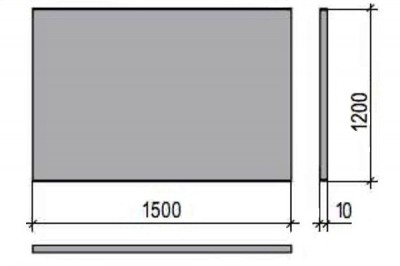
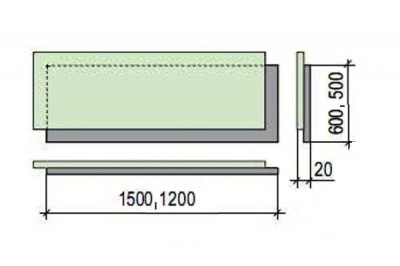
Often for the construction of two, three or more layers of a precast base, sheets of equal sizes are used, but it is possible to use elements with different geometric parameters. For example, the first horizon from the insulating layer is laid using small-format elements, the second of large-format plates, or vice versa. The main condition is the mismatch of their direction, since the installation and gluing of each layer should be made "in the cross" of the previous one.
The specifics of laying GVL elements
A number of manufacturers of finishes and building materials produce prefabricated leveling systems with a complete set of sheets and fasteners for the construction of a single and multi-layer leveling structure. Amid the mass of offers from domestic and foreign manufacturers, it stands out products with the Knauf brand. The international concern provides customers with instructions on how to assemble floors from gvl.
A specific feature of the construction of the floor from the GVL is the uniform displacement of the panels, as a result of which the floor layer in the plan resembles brick laying, which increases the contact area of each of the elements with the sheets next to it. This technology provides maximum strength.
Attention. The offset of the butt welds in each of the subsequent series of hot water lines relative to the previous ones should not be less than 20 cm. The optimal size of the offset of the butt joints is 25 cm.
Plasterboard flooring
The start of the dry screed construction is preceded by standard floor preparation. The rough concrete base is repaired and ground if necessary. If it is planned to lay gvl on a wooden floor, the reliability of fastenings and elements made of wood, the horizontality of all components of the structure constructed from timber, are checked.
The damper tape is a kind of vibration damper, its absence causes expansion of the screed with temperature and other external changes, which can become the main cause of damage to building elements. You will learn more about the damper, the types of material and how to choose it here:https://floor.expertexpro.com/en/ustroistvo-rmnt/dempfernaya-lenta-dlya-styazhki.html.
So, the order of work:
- A slight roughness of the cement base (up to 5 mm) is eliminated by local filling of the recesses and sinks with a repair mortar. To level large differences (more than 20 mm), fine-grained expanded clay is used.
- The rough surface is covered with a waterproofing layer, the edge of which is bent around the perimeter on each of the walls. For a concrete base, polyethylene (0.2 mm thick) lined with strips is suitable as a waterproofing layer.
- An insulating tape with a width of 0.1 m and a thickness of 1 cm is laid along the contour of the installed dry screed. To do this, either a special tape made of expanded polystyrene is used or it is cut out of mineral wool. Other insulating materials with a similar structure will do. Compensation circuit is necessary to prevent cracking and “swelling” of sheets due to deformation of floating floors. It also enhances sound insulation.
- Cutting GVL taking into account the edge gap.
- Insulation is falling asleep. It is mainly used for this washed river or quarry sand, less commonly fine-grained expanded clay. Amorphous insulation must be aligned with the marks marked with a level gauge.The minimum thickness of the backfill layer is 20 mm. If the thickness of this layer exceeds 10 cm, it will be necessary to build a three-layer dry screed from GVL.
- The floor structure on the logs can be insulated with stone or glass wool, you can put polystyrene foam cut into small plates.
- On top of the insulating layer, the GVL is laid in accordance with the above rules. The gap between the gypsum fiber elements should not be more than one mm.
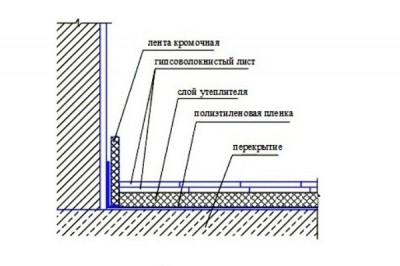
Note. If it is planned to put gvl on a wooden floor, vapor-proof materials are used as waterproofing: corrugated or waxed paper, glassine and other vapor barrier materials.
If the installation of sheets of dry screed begins from a wall located opposite the door so as not to disturb the horizontal surface of the insulating layer, it is necessary to make a kind of track or "islands" from the plates to move. It is recommended that the construction of a leveling system from GVL on top of heat-insulating plates from the opposite wall. Here's what we do next:
- The first layer of dry screed is carefully covered with adhesive mastic or dispersion of PVA. Adhesives should be applied between each layer of gypsum fiber screed, if you plan to create a multilayer structure.
- The second layer of the screed is covered on top, the elements of which are perpendicular to the direction of the elements of the lower layer. To connect large-format panels and sheets with a fold, in addition to glue, they also use self-tapping screws (there must be a distance of more than 30 cm between them). Small-format GVL are treated with glue around the perimeter and also connected with self-tapping screws, but they are installed at least 20 cm.
Before proceeding with the leveling of the floor surface, it is necessary to beat off the horizontal level of the room, which can be oriented during the work. On how to do this and how to use the water and laser levels, read on our website:https://floor.expertexpro.com/en/viravniv-stazhka/kak-otbit-uroven-pola.html.
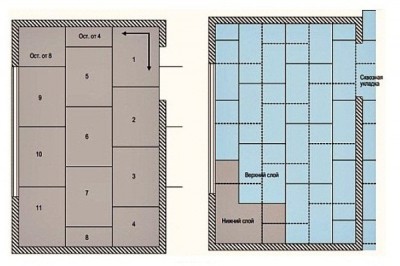
Important. To work with gypsum-fiber material, special double-thread self-tapping screws and a self-countersinking device are required. The fasteners intended for drywall are not suitable, as they are capable of spontaneously twisting out of the HVL.
It is not worth fearing too much consumption of small-format material with a fold, since the trimmings obtained in the mating zone are transferred to the beginning of the next row. There will definitely be no waste. In addition, the advantages of small sheets of GVL include the ability to start laying from any of the walls, which is especially important when arranging rooms of a non-standard configuration.

Important. A solid sheet should lie above the cross connection of the lower layer. The combination of seams of the lower and upper layers is unacceptable.
After all work, the joints and installation points of the screws are sealed with putty. The final work is the removal of the parts of the waterproofing and the edge band protruding above the floor surface. Everything is ready for installation of the finish coating.
Technological advantages of gypsum fiber sheets convince property owners of the possibility of independent work, which is fully justified by the simplicity of the dry screed construction scheme. Moreover, for yourself, the device of floors from gvl will be made with incredible accuracy, inaccessible to third-party, always rushing performers. Learned a simple process? Now forward to the implementation of plans.

